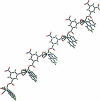catena-Poly[[aqua-(2,2'-bipyridine-κN,N')copper(II)]-μ-5-nitro-isophthalato-κO,O:O]
- PMID: 21581121
- PMCID: PMC2959803
- DOI: 10.1107/S1600536808035150
catena-Poly[[aqua-(2,2'-bipyridine-κN,N')copper(II)]-μ-5-nitro-isophthalato-κO,O:O]
Retraction in
-
Retraction of articles.Acta Crystallogr Sect E Struct Rep Online. 2012 Apr 1;68(Pt 4):e10-1. doi: 10.1107/S1600536811037597. Epub 2012 Mar 31. Acta Crystallogr Sect E Struct Rep Online. 2012. PMID: 22589748 Free PMC article.
Abstract
In the asymmetric unit of the title compound, [Cu(C(8)H(3)NO(6))(C(10)H(8)N(2))(H(2)O)](n), there are two symmetry-independent one-dimensional coordination polymers related by a non-crystallographic inversion center. Within the polymers, the Cu(II )atoms, coordinated by the water mol-ecule and the chelating 2,2'-bipyridine ligands, are bridged by 5-nitro-benzene-1,3-dicarboxyl-ate dianions which act as tridentate ligands; the carboxyl-ate groups exhibit monodentate and symmetric bidentate coordination modes. The Cu(II) atoms show a strongly distorted octa-hedral coordination geometry. In the crystal structure, the two symmetry-independent coordination polymers form another one-dimensional polymeric structure via O-H⋯O hydrogen bonds between coordinated water mol-ecules and carboxyl-ate groups.
Figures
References
-
- Bruker (2001). SADABS and SAINT-Plus Bruker AXS Inc., Madison, Wisconsin, USA.
-
- Bruker (2004). APEX2 Bruker AXS Inc., Madison, Wisconsin, USA.
-
- Church, B. S. & Halvorson, H. (1959). Nature (London), 183, 124–125. - PubMed
-
- Kim, Y., Lee, E. & Jung, D. Y. (2001). Chem. Mater.13, 2684–2690.
-
- Okabe, N. & Oya, N. (2000). Acta Cryst. C56, 1416–1417. - PubMed
Publication types
LinkOut - more resources
Full Text Sources
Molecular Biology Databases
Research Materials


